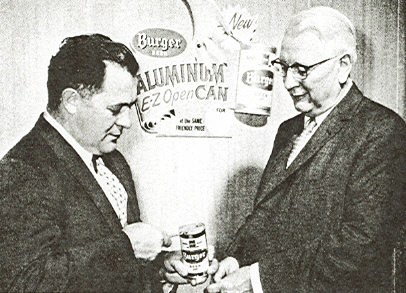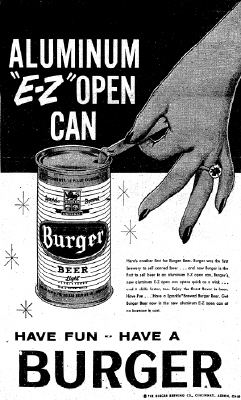Burger Beer E-Z Open Top (1960)
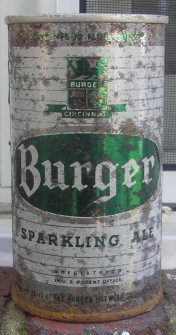 |
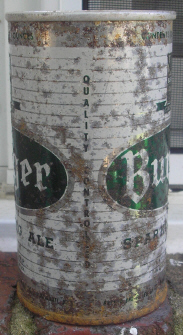 |
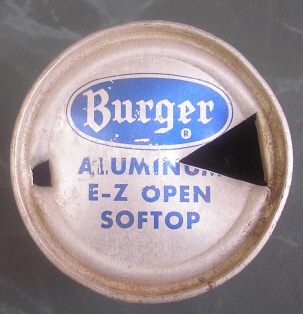 |
This month's can is special because of its lid. It's a short-lived feature designed to get around the problems some people had using a churchkey to open flat tops.
Burger Brewing
Sometime in the future I’ll cover the early history of Cincinnati’s Burger brewing Company. I want to make a Can-of-the-Month featuring earlier Burger cans. So lets start this month’s story after World War Two. Cincinnati had numerous breweries active when the war ended, including Red Top, Hudepohl, Schoenling, Delatron and Burger (plus Bavarian and Wiedemann across the Ohio River in Kentucky). However, during the late 1940s and early 1950s breweries around the country continued to close as small breweries proved unable to compete with the big national companies as well as the larger regional brewers. Even some of the more powerful regional breweries, such as Cincinnati’s Red Top, closed.
Burger Expands
Burger Brewing had begun expanding in the 1950s. In the 1930s and 1940s they had expanded their market into the Midwest as far as Missouri and throughout the south. Hudepohl and Red Top had both established second brewery plants in Cincinnati. Burger was the only Cincinnati brewery to expand by buying a brewery in a different area. In 1956 they purchased the Burkhardt Brewery in Akron. This not only would allow for greater production, but would also allow Burger to expand their market into Burkhardt’s marketing area in northern Ohio, Michigan and in neighboring states to the east. Burkhardt Beer was discontinued, but Burger continued making Burkhardt’s Mug Ale in Akron. The new brewery allowed Burger to produce another 300,000 barrels a year to go along with the 1,500,000 the Cincinnati plant could produce.
Aluminum Cans
By 1960 several breweries had been experimenting with aluminum cans. Some European breweries were already using them. Coors was producing a 7 oz aluminum can. Hawaii’s Primo Brewing’s disastrous experiment with their new lightweight can was covered in my [DATE] Can-Of-The-Month. In 1960 Burger teamed up with Cincinnati’s Heekin Can Company and Kaiser Aluminum to produce a can with the normal steel and tinplate body, but with an aluminum lid. This new lid made only a slight reduction in the total can weight, but it was much easier to open with a church key.
|
Burger began marketing the new “E-Z Open” can in the summer of 1960. They began selling the E-Z Open cans in nearby southern Indiana, Kentucky and West Virginia. They then expanded into their other markets once the new lid proved to be popular. The fact that Burger tried their new lid in their close home markets show how confident they were that it would be a success. In many cases breweries would experiment with new technologies in area away from their home market. If the experiment fails it would have less of a negative impact on sales. For example, Krueger, the first company to sell beer in cans, first tried beer in cans in Richmond, Virginia, at the extreme edge of their market. In 1963, when Iron City tested the first pull top can, they tested them in Staunton, Virginia, away from their home market centered in Pittsburgh. Apparently Burger didn’t feel the need to be so careful with their new aluminum lids. |
| Frank Sellinger (left) Vice-President and General Manager of Burger Brewing and Clarence Rolfes, Vice-President in charge of sales of the Heekin Can Company demonstrate the new E-Z Open can. |
 |
|
Two ads promoting the new E-Z Open cans (click to see larger)
Burger’s Troubles
Even though Burger seemed to be doing well in the early 1960s, the expansion into Akron had not worked as well as expected. In January 1964 Burger announced that the Akron plant would be closed. In 1968 they tried a cost-cutting measure, switching to artesian well water which they could tap from sources under the brewery. They launched a huge advertising campaign, “Brewed with pure artesian spring water.” The new water, however, failed to save much money, and, even worse, changed the beer’s flavor. Customers abandoned the brand and in 1970 Burger took its common stock off of the market. At 12:01 am, March 16 1973, when their labor contract expired, Burger closed. Hudepohl bought the Burger brands, but not the brewing facility.
See my new Soft Top page for more on this type of lid.
Sources Used
Brewer's Digest. July 1960
Holian, Timothy J. Over the Barrel: The Brewing History and Beer Culture of Cincinnati. Volume 2. Prohibition-2001. (Sudhaus, 2001)

